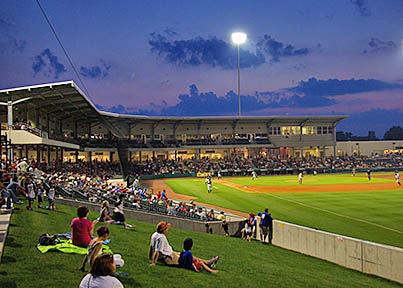 |
“It’s really easy being a fan here,” said Brad Taylor, General Manager of the South Atlantic League’s new team in Bowling Green, Kentucky.
| Ballpark Stats |
 |
| Team: The Bowling Green Hot Rods of the Class A South Atlantic League |
| First game: April 17, 2009 — an 8-4 win over Kannapolis |
| Capacity: 6,800 (of which 4,559 are fixed seats) |
| Architect: DLR Group |
| Construction: Alliance |
| Price: $28 million |
| Home dugout: Third base side |
| Field points: northeast |
| Playing surface: Mixture of bermuda and rye |
| Betcha didn’t know: This is the fourth home field for this franchise this decade, having also played in Wilmington, NC, Albany, GA and Columbus, GA. |
I’d asked Brad what he liked about brand-new Bowling Green Ballpark, the home of his Hot Rods, and that’s how he expressed his sentiments.
Fair enough. The focus is on the fans here, with lots of wide-open spaces in which to congregate and move around, and abundant group areas. “Hospitality is the story here,” he told me.
This is a franchise that has found little hospitality over the past decade. When the Sally League expanded to 16 teams in 2001, it placed new franchises in Lexington, KY and Wilmington, NC. The Lexington Legends moved right into a newly constructed park, while the Wilmington Waves played at a sub-standard facility on the campus of UNC-Wilmington in anticipation of a new stadium being constructed downtown.
Well, that new park failed to materialize, so the franchise looked elsewhere. The first move was to Albany, GA where there was a park that had been abandoned by pro baseball a couple of years before. This was probably viewed as a temporary solution, because Columbia, SC made noises about making a new park the centerpiece for a huge development, and this franchise clearly wanted to be the team to play there.
That development in South Carolina fell apart, and the team instead moved north from Albany to Columbus, GA into Golden Park, another facility from which Minor League Baseball had previously fled. Attendance was quite poor for the Columbus Catfish, including a first-year total of only 30,000 for the entire season when they moved there in 2003. Attendance never topped 70,000 any year they played in Columbus, so the vagabond franchise was ripe for the picking when the City Commissioners of Bowling Green approved a $100 million project to revitalize the city’s historic downtown, and that project included a new stadium.
An entity called the Warren County Downtown Redevelopment Authority was formed to oversee the urban-renewal work, and the ballpark project was put on a fast track — and the Columbus Catfish were eager to be the tenants. “From the first time we drew a line on a sketch pad to (the ballpark’s) opening day was 13 months,” said Greg Garlock, a principal at DLR Group. Not only did Greg and his team design Bowling Green Ballpark, they were also the architects of the spectacular West End Field in Greenville, SC, which was named our Ballpark of the Year in 2006.
So the former Columbus Catfish became the Bowling Green Hot Rods (the nickname is a nod to the General Motors plant that assembles Corvettes there), and they moved into the hastily built facility on April 17, 2009. How did this fast-tracked ballpark turn out? Well, it certainly wasn’t 100% finished when it opened its doors, but as the season progressed, more and more of it was completed, and by the time of our visit in July, it was fully functional. So let’s take a look at its setting, exterior, interior design and fan amenities.
The Setting
Bowling Green strikes me as a college town. There’s nothing wrong with that. I loved my college years in a town where the university is without a doubt the biggest thing there.
The campus of Western Kentucky University sits on the southern edge of Bowling Green’s downtown — a downtown without many major buildings. In fact, I would go so far as to say that the vast majority of large buildings inside the city limits belong to WKU.
Bowling Green certainly possesses a lot of history, and the central commercial area has quite a few cute shops and restaurants … but without a coordinated, well-funded effort, that downtown was probably heading the way of the dinosaur. That’s because most of the development in the area was happening south of town, near Interstate 65.
 |
So the “redevelopment” of the downtown was approved, and the location selected for the ballpark was on the northern edge of the business district, on the opposite side of downtown from the college campus. You’re in walking distance of some of the shops and eateries, but the most noteworthy new structure nearby is the spectacular Chamber of Commerce building about two blocks to the east (see photo above). A gorgeous theater is scheduled to be built between it and the park.
For the ballpark’s first season, I wouldn’t quite say that its neighborhood is a “destination” that would attract visitors from far and wide (Fort Wayne’s Harrison Square, where the new ballpark is the centerpiece, is definitely worth traveling to see), but the baseball facility is an important piece to Bowling Green’s urban-renewal puzzle.
The Exterior
“A lot of the character of the ballpark is driven by its site,” Garlock told me. That’s because Bowling Green’s new stadium doesn’t sit neatly within a city block, with the foul lines running parallel to the streets.
“The team owners liked what we did in Greenville, but they didn’t really like the entry,” he continued. There was a strong desire for a distinctive entry plaza, “and we couldn’t have accomplished that if we’d designed the park parallel to the streets.”
 |
Further, there were practical considerations to deal with. “There was a lot of rock on the site, especially on the right side,” said Garlock. With a residential area just beyond the outfield, they didn’t want an excessive amount of blasting that would have been necessary to excavate the sunken playing field.
So DLR “rotated” the park’s footprint off of the normal street grid. This meant that home plate wasn’t near the intersection of streets. Instead, the part of the park’s exterior closest to home is in the middle of the city block (below left). Not only did this avoid the explosives that would’ve been necessary to dig out the field where there was an abundance or rock, this also allowed a desirable northeast orientation of the field. In addition, the owners were happy because the extra space behind first base and third base permitted not one but two large entry plazas outside the gates. The one that is used most heavily (because it’s closer to parking and most of the town’s restaurants and such) is the one behind first base (above). This is where the ticket windows are, as well as the team offices. This space tends to get a little cluttered, with things like metal barriers and a van from a radio station.
However, I think the more aesthetically pleasing entry is behind third base, even though it isn’t used nearly as often by fans. Here you’ll find attractive landscaping and a nice set of steps up to the gates (below right). And the team doesn’t clutter it up with extra promotional items.
 |
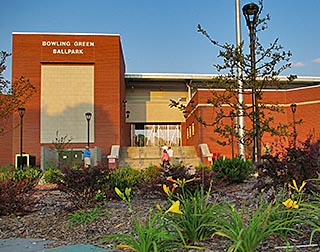 |
The exterior building materials, as the photos show, are brick and stone block. It’s not a takes-your-breath-away look like the new parks in Fort Wayne or New York, but it provides a clean, classic appearance.
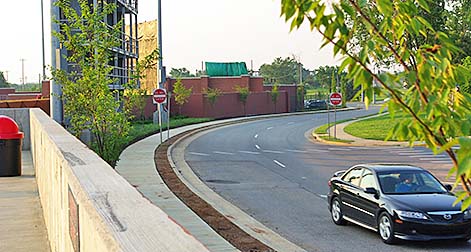 |
One of the most unusual aspects of the exterior won’t be seen by many fans at all — unless they happen to live in the neighborhood beyond the outfield. That’s because of the curving street beyond right field (above). This impacted the shape of the ballpark’s footprint, which was further influenced by the decision to orient the park off of the street “grid.”
The Design
By no means would I characterize the architectural design of Bowling Green Ballpark as “groundbreaking,” in the way that Huntington Park in Columbus is. It is, however, somewhat aesthetically pleasing and very, very functional.
To me, the most impressive aspect of the ballpark is the abundance of space — in the entry areas, on the concourses, in the souvenir shop, in the group areas and even in the team offices. By designing the park with all of this space, there is ample opportunity to expand or add new features down the road — plus you get an open concourse. “When you stand on the concourse, your view of the field is never blocked,” noted GM Taylor.
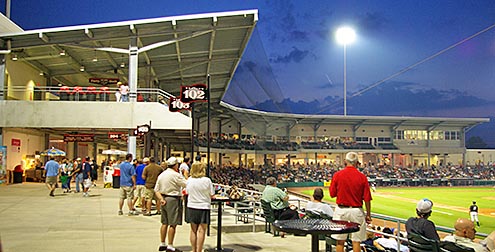 |
Another noteworthy aspect of the design is the outfield. Because of the placement of the bullpen and the aforementioned curving street beyond right field, the outfield dimensions are unusual. Right-center field is much closer than left center (the actual dimensions for the power alleys aren’t shown on the fences), and the right-field wall curves as it runs parallel to the street (see photos below).
There are curving outfield walls elsewhere (e.g., Midland, TX and Albuquerque), but they are usually done for no special reason other than to be different. “I’m a little bit of a traditionalist,” Garlock told me. “For us to do what we did (with the curving wall), there was a reason to do it.”
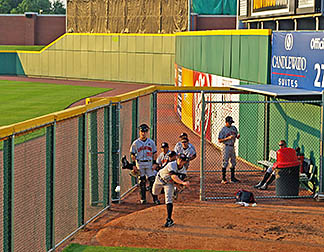  |
Like the new park in Reno, the pressbox isn’t behind home plate. At Aces Ballpark, the non-broadcast media folks work in an area all the way down the first-base line on the upper level. That was so that the team could sell luxury suites that were directly behind home plate. In Bowling Green, the pressbox is on the opposite site of the field (below left). “We decided to put the pressbox in the (left field) corner so our fans would have preference in the view of the field, especially in the upper deck,” said Taylor. Indeed, on the upper level behind home plate is a gorgeous lounge that accommodates up to 200 fans (below right). It’s one of the nicest I’ve seen in the Minors.
This still means the pressbox isn’t behind home plate, and I feel like that’s where it should be. Like in Reno, it wasn’t in the budget to build a third level for the media to be behind home, so the radio booths and the “working press” look at the action from down the left-field line.
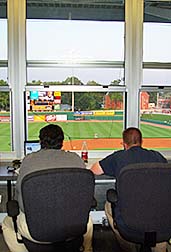  |
One architectural element that I really like, though, is the overhang (below left). Considering the overall size of the park, the roof is perhaps disproportionately large — but I’m not complaining. The only problematic aspect of this is that once the sun goes down, the seating sections are blocked from the light towers, and it tends to be fairly dark. Not as dark as the seats in Jacksonville where the roof might be the largest in the Minors, but it’s still kind of hard to see.
  |
Taylor is deservedly proud of the intimacy of the seating bowl, as he emphasized that the most rows any section has is 14. Garlock added that, “I was really happy with how the seating bowl turned out.” This kind of intimate, close-to-the-field arrangement is very reminiscent of Greenville.
Right field isn’t the only side of the ballpark where the position of the bullpen makes for an unusual arrangement. In the left-field corner is the home bullpen (below left), and the way it juts into the field creates crazy bounces when a ball is hit into the corner (below right).
On the center-field side of this bullpen is the Home Run Grill group area. Both Taylor and Garlock made note of this spot’s great location and view of the action.
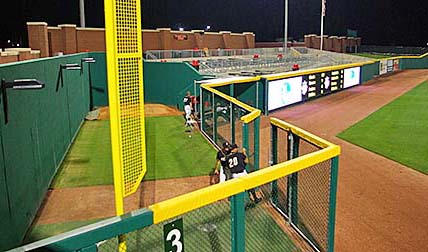  |
All in all, a nice, solid architectural design with ample room to expand.